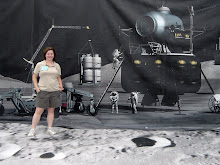
This week, I am up at the Goddard Space Flight Center in Maryland for a project science meeting for the Lunar Reconnaissance Orbiter (LRO). LRO is our first step toward fulfilling the Vision, that is, gaining a foothold on the Moon and using it as a stepping stone toward explanding outward.
LRO is carrying seven instruments on board to look for water, understand the radiation environment, and acquire high-resolution information on topography, temperature, roughness, slopes, and imagery to characterize potential landing sites. At this point, the instruments are all built and undergoing individual acoustic, vibrational, and thermal vacuum testing. After they have been individually tested, they will be delivered to the spacecraft integrations center in the next two months. Then they will be integrated onto the spacecraft body and the whole thing will tested together.
LRO is scheduled for launch in 2008 on an Atlas V 401 rocket. No time to delay ops concepts or calibration for the cruise phase, as LRO takes a direct flight to the Moon in four days. The spaceraft spends a year in a circular polar orbit approximately 50 km above the Moon's surface, closer than any other lunar mission. During this time, it will be making global maps and acquiring observations for ESMD that they need to start planning for landing sites. After a year, control of the spacecraft will be turned over to science and while the spacecraft is still functional it will be used for science observations, possibly including a change of orbit to a more fuel-efficient elliptical orbit.
The LPRP at MSFC (where I work) is the program management office for LRO, Goddard manages the spacecraft, like integration and operations, and the seven instruments onboard all have individual principal investigators (PIs) and science teams. This makes LRO a much different flavor of space mission than, say, the Mars Exploration Rovers where we have a single PI and one coherent team. So, the project science meeting has been great for me to meet the team members (though I already know many of them of course), meet the management, and get instrument updates. The team spent a lot of time here discussing operations scenarios for when we actually get up there. There are some interesting ways of coordinating observations among instruments to make a richer science story than just simply leaving instruments switched on on a nadir-pointing orbit. But they take some time and agreement. We also spent some time thinking about how to co-register all the data together and tie it to the new reference frame that LOLA, the laser altimeter on LRO, will provide.
It definitely got me psyched for this mission, which we hope will be the first of many robotic missions to the Moon! But wait, why do we need LRO when there are three other international lunar orbiters, anyway? Next post, I'll tell you.

No comments:
Post a Comment